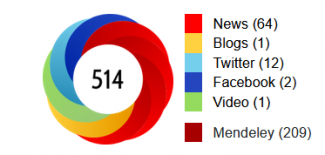ORBi collects, since 2008, a variety of quantitative data for mapping the Institution's scientific production and outreach and to observe the deployment of Open Access.
It is important to use them in combination, taking into account the context and associating them with a qualitative assessment, as recommended by international initiatives like DORA (San Francisco Declaration on Research Assessment) and the Leiden Manifesto.
The number of citations measures the number of times a document has been cited by other scientific publications, within a given corpus and over a given period of time. This number, therefore, differs depending on the databases (Web of Science, Scopus, Google Scholar, PubMed, etc.), which do not have the same scope.
In ORBi we offer citations from different databases :
These are alternative measures aimed mainly at highlighting the use of scientific publications on the Internet, using, among other things, shares on social networks (Twitter, Facebook, LinkedIn ...), downloads on platforms such as Mendeley and mentions in blogs or wikis.

This index attempts to measure both the scientific productivity and the apparent scientific impact of a scientist. According to Hirsh: "A scientist has index "h" if h of his/her papers have at least h citations each, and the other papers have no more than h citations each."
In ORBi, the "h" index is based on the number of citations of the references listed in the report. For each citations provider (Scopus, OpenCitations...) there is a corresponding h-index. The h-index appears in the bibliometric synthesis of the publications report.
Impact factor
Subscription cancelled by decision of the BiCfB Council of Rectors (CREF) in 2016
Service blocked by Google Scholar
End of service on December 2021
End of service in 2015